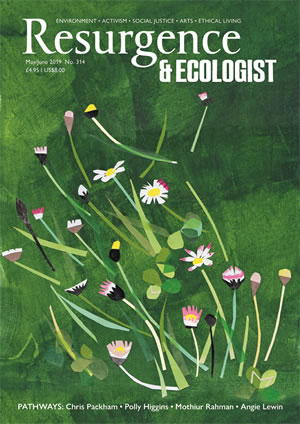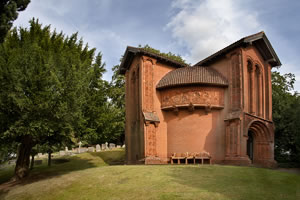It was one of the first days of summer. We left Farnham, crossed the River Wey and walked up onto the ridge of the North Downs. The new leaves of the oak and the beech were dazzling in their brightness. In the woods, the overhanging branches above the path created a soft green tunnel that stretched towards a dark and inviting circle far in the distance. Sunlight filtered through the canopy; we could sense the heat, but kept cool beneath the leaves.
These hills are inhabited by more than just woodpeckers and yew, ash and skylarks. Surrey is perhaps the most private county in England. For centuries, its closeness to London has made it the residence of aristocrats, executives and bankers. This is the landscape of cultivated power, where architecture and Nature combine to create a sense of comfort and calm, far from the raw realities of the world beyond. It is also the place where the Arts and Crafts movement took physical form in a series of red-brick mansions designed by Edwin Lutyens, Philip Webb and Charles Voysey.
As the sun rose higher, we followed signs announcing the Watts Gallery and Artists’ Village. Soon we found ourselves in a low-slung, brick-built complex, a special place in the woods for the art of George and Mary Seton Watts.
By the 1880s, London’s coal-fuelled smog had reached apocalyptic proportions. Some feared that the capital of the world’s greatest empire might have to be abandoned as the so-called fogs got worse and worse. In 1886, the sulphurous yellow smoke blotted out the sky for 86 days in the year. Pollution spurred an exodus out of London, aided by the railway networks. Two of the people fleeing the London air were 72-year-old George Watts and his young wife Mary. Known as ‘England’s Michelangelo’, George was a renowned painter of both society portraits and ambitious conceptual works, many of which sought to inspire social progress. Mary’s craft was ceramics, and before their marriage she had taught clay modelling to the working classes in Whitechapel at the Christian Socialist settlement at Toynbee Hall.
In 1889, the Wattses headed south to find a winter retreat to escape the pollution that was destroying George’s health. They chose Compton on the south slope of the Downs and commissioned the Arts and Crafts architect Ernest George to build them a house, which they named Limnerslease, expressing Mary’s hope that this new home would bring them “golden years” in the forest.
Mary and George built their own unique cultural settlement around the house. A purpose-built gallery was opened in 1904. Today, the gallery almost disappears into the surrounding greenery, the emerald-tiled front like the flash of a parakeet. Inside, the largely forgotten work of George Watts is startling in its diversity and power. A selection of portraits he painted for his Victorian ‘Hall of Fame’ are displayed on the walls at Compton, including the East India executive, economist and liberal philosopher John Stuart Mill as well as the incomparable poet, designer and revolutionary socialist William Morris.
Just south of the house and the gallery stands a jewel of a chapel designed by Mary and built of bricks made from a seam of local clay. The chapel is a nugget of glowing orange-red, a small piece of Byzantium in southern England. The small circular building is covered with Mary’s ‘Celtic Nouveau’ designs, combining a host of artistic and spiritual strands. “My hope is that Terra Cotta shall be my Rita,” Mary wrote, using the Hindi word to signify her sense of embarking on her true path. Terracotta tiles, handmade by over 70 villagers and full of natural imagery of herons, owls, peacocks and eagles, adorn the outside. Inside stands a sprawling Tree of Life alongside George’s art. For something that was built as a place to mourn the dead, the chapel is extraordinarily light and joyful.
Today, Mary would be known as a social entrepreneur, founding her Potters’ Arts Guild in Compton, with a profit-sharing arrangement with the workers. Inspired by pre-capitalist economic models that had been revived by John Ruskin, she was one of a generation of cultural philanthropists who tried to use arts and crafts to improve the lives of people living in poverty. She was active in the rising women’s movement and became president of the local branch of the suffragist National Union of Women’s Suffrage Societies, led by Millicent Fawcett.
George Watts died in 1904 and lies buried under the beech trees a few steps away from Mary’s chapel. Mary continued with her Arts Guild until 1936, when it shifted into more conventional private ownership; she died two years later. The Compton Pottery struggled on until 1951, when the post-war Labour government’s restrictions on non-essential production proved to be the final straw. Clement Attlee, the prime minister who oversaw these post-war socialist controls, kept a framed print of George Watts’s joyous 1870 portrait of William Morris on the wall of his study. Unintentionally, his government’s measures had snuffed out one of the last living links with the Arts and Crafts era.
The gallery slumbered for another half-century until an inspired renovation restored George and Mary’s dream of an artistic beacon in the Surrey hills.
The sun was starting to slide as we left Compton and rejoined the Pilgrims’ Way. So many English heritage attractions sink into a warm bath of twee, combining cream teas and a strange nostalgia for an age before democracy. What rescues Compton is the integrity of George’s vision and Mary’s dedication to the uplifting power of craft. Our heads spinning, what remained as we walked on was a powerful sense that the resolution of our own burning social, ecological and economic injustices would involve a similar mingling of art and activism, a similar creative tension between ethical reform and structural change.
This essay is part of a series that is wending towards a new type of walking guide for the North Downs Way due to be published in 2021.








